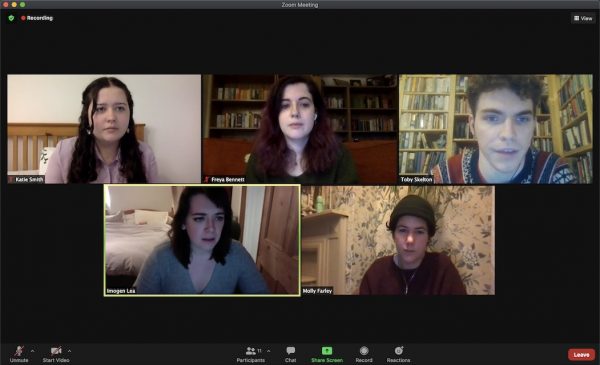Working on Senseless: Creative Research and Development in a Pandemic
‘I didn’t think I was a really visual person. I thought I was very linguistic until I was kind of struggling to imagine how different elements look,’ says James McDermott.
As the Covid-19 pandemic continues to make in-person collaboration difficult to impossible throughout the winter months, James McDermott and Guildhall Live Events (GLE) have jointly taken on the current challenges by devising unique virtual workshops for Senseless, James’ theatrical work which will be presented with the Norwich Theatre in May, 2021. Over the last week, GLE and James met twice in order to co-develop the digital set design for the stage and to discuss the form of the theatre piece through an online table reading and discussion of the work.
It has become evident that workshopping theatre necessitates ‘being in the room’ together. The virtual visit to Guildhall School’s television studio in Milton Court, London, provided an opportunity to look at and discuss the interactive and scenic visual aspects of the work in a real space. Via Zoom, GLE team members Dan Shorten and Richard Moores and third-year Video Design for Live Performance student Charlie Vince-Crowhurst walked James and the UEA team through their experiments with three-dimensional virtual scenic design, which digitally integrates moving actors, set pieces and projection technology.
The process allowed for a conversation around the visual elements of the project so that the technologists and writer could work collaboratively through the linkages between story, character, action, set and imagery. The GLE team carried their laptops around the space to show us what they saw in the theatre and what was digitally mapped onto the space on separate monitors. James made the observation that ‘as I can see things, I’m realising […] I didn’t think I was a really visual person. I thought I was very linguistic until I was kind of struggling to imagine how different elements look. That is until now that I’m seeing visual examples.’
The next week, we met again to see and hear actors perform the script. Future and Form project lead, Steve Waters, organised a reading with Mike Bernardin, Lecturer in Drama at UEA, who convenes a weekly acting workshop called the UEA Ensemble LAB with recent and current acting and writing students. This week the participants included Freya Bennett, Molly Farley, Imogen Lea, Toby Skelton and Katie Smith who brilliantly performed scenes from James’ draft.
Something that is particularly interesting about Senseless is how its content mirrors the challenges and complexities that remote working has created for the production process of this very piece. His contemporary dystopian theatrical work pictures a time when governmental controls strip individuals of their rights to communicate with each other through a series of restrictions on the body (no touching, no speaking, no dancing). In the online table reading, the irony of rehearsing this project while physically removed from each other, planted at our respective desks, coffee and kitchen tables, sofas and bedrooms, was not lost on any of the participants.

There was, however, still a live-ness to the experience. It was exciting to witness the actors interpret and embody the characters and scene direction. Further, there are evident gains in working this way, regardless of the ever present loss of contact and the experience of being together. The addition of the creative technical team from GLE into the collaborative process of writing and rehearsing meant that the content and form of the writing and the technical and scenic design could be developed in tandem. For example, Imogen Lea brought to the table the possibility of integrating accessibility into the creative design process and James was able to loop this suggestion back into his artistic concerns that have always involved inclusivity and audience engagement. Additionally, Dan, from GLE, could make linkages between the thematic concerns that arose from the group discussion, such as corporeality, alienation and our ‘digital afterlives’, and the kinds of imagery and spaces that will be represented in the virtual design.
In some sense, the requirements of working remotely have made quick video check-ins more frequent than might happen in another production. James is able to write with the technology and set, not before it is considered nor after it is developed. Adaptation happens on the technological end and on the written end in a back and forth conversation. Since provisionality is preferenced in this experimental process, the writing and digital creation processes work as dialogue. James is given the opportunity to see, to ask and to rewrite and GLE has much the same opportunities: to read, to ask, to remake. Further, the process allows for interactions with the wider Future and Form team and creative individuals, such as Mike Bernardin and the members of his acting and writing group.
